News | METRANS, PSR, host Wei for Economic Impacts of Cargo Handling Equipment Electrification
Stop the VideoNews

METRANS, PSR, host Wei for Economic Impacts of Cargo Handling Equipment Electrification
Tuesday, November 9, 2021
by Hayley Rundle, USC Master of Urban Planning
On October 27, METRANS and the Pacific Southwest University Transportation Center (PSR), launched their third in-person (with a remote attendance option) research seminar for the Fall 2021 seminar series. Titled “Economic Impacts of Cargo Handling Equipment Electrification at Port of Los Angeles/Port of Long Beach,” this event showcased the research of University of Southern California (USC) Sol Price School of Public Policy Professor Dr. Dan Wei and Professor and METRANS Director, Dr. Genevieve Giuliano. Dr. Wei presented the research and research findings at the seminar on behalf of the research team.
Dan Wei is a Research Associate Professor at the USC Sol Price School of Public Policy. Her research focuses on economic consequence analysis of natural or man-made hazards, modeling of economic impacts of climate mitigation policies, and analysis of market-based greenhouse gas (GHG) mitigation policy instruments. Wei holds a BE degree in Engineering Physics and an MSc degree in Public Policy from Tsinghua University, and a PhD in Geography from Pennsylvania State University.

Professor Dan Wei
The event drew a passionate crowd of public and private sector transportation professionals, faculty, researchers, and students at all levels of study. The session began with a formal presentation and ended with a discussion of the audience’s questions.
Wei began the presentation with a background of the study. Wei described how the research is part of a larger project to track economic competitiveness of the freight transportation sector under implementation of the California Sustainable Freight Action Plan (CSFAP) with electrification of cargo handling equipment (CHE) as the focus of this study. Zero emission cargo handling equipment is one of the major strategies in the Port of Los Angeles/Port of Long Beach Clean Air Action Plan (CAAP) and, additionally, the California Air Resources Board (CARB) is planning to implement new regulations related to freight and CHE effective 2026. The CAAP’s primary goal is to have a zero-emissions fleet by 2030.
The scope of the research primarily focuses on estimating the economic impacts of electrifying cargo handling equipment at the Port of Los Angeles/ Port of Long Beach and then comparing the cost of equipment, infrastructure, fuel, and operations and maintenance expenditures relative to baseline operations and turnover of conventional cargo handling equipment from 2020 to 2045. Types of cargo handling equipment at the ports include yard tractors, RTG cranes, top handlers, side picks, and forklifts.
The research utilizes the Regional Economic Models, Inc, also known as the REMI model, for analysis. The REMI model is one of the most widely used state- and national-level macroeconomic modeling tools in the United States. The model has been used to analyze economic impacts in several topic areas ranging from the transportation sector to the energy sector to the commercial sector. The REMI model starts with a policy selection that produces micro-level analysis results. Macroeconomic modeling is then done with the mapping of micro-level analysis results to REMI inputs, which then produces macroeconomic analysis results. The policy simulation portion of the REMI model follows 5 steps from policy question formulation to measurements of policy impacts.
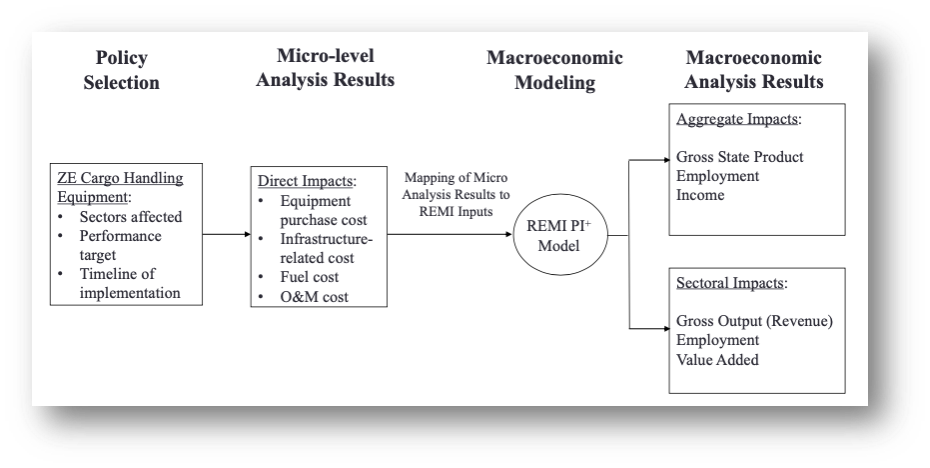
REMI model approach flow chart
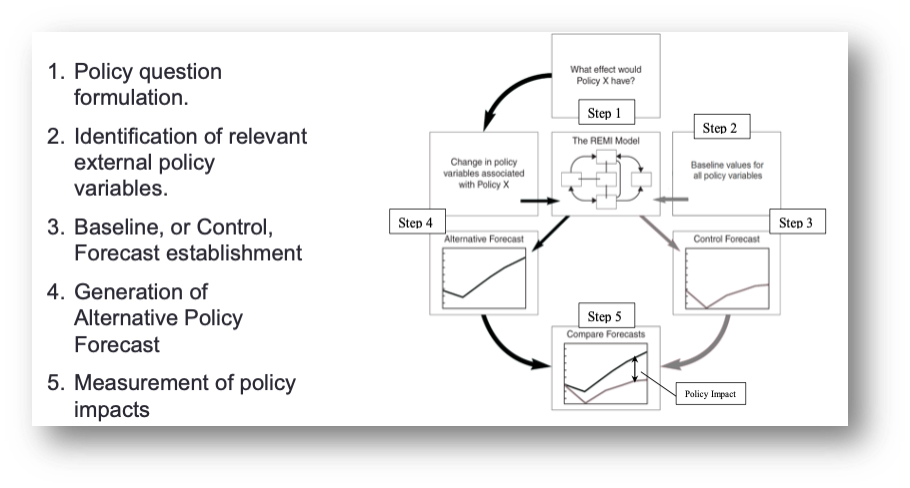
Policy simulation in the REMI model
The REMI model includes major assumptions based upon best available date for four categories: capital costs, operations and maintenance costs, energy costs, and payor (who pays). The major assumptions are shown in the graphic below. The model then produces two main sets of results: direct impacts and macro-economic impacts. Direct impacts include capital investment costs, operating costs, maintenance costs, and energy costs. The macro-economic impacts include impacts on the state economy and impacts on sectors in the industry. The macro-economic impacts were measured as four categories: job-years gained or lost, change in gross state product, change in state output, and change in person income.
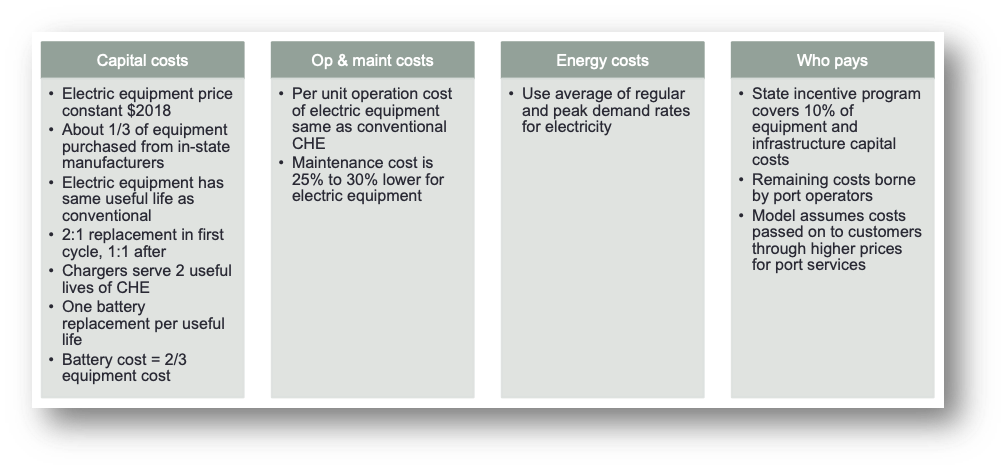 Major assumptions of the REMI model
Major assumptions of the REMI model
Wei then went over the results produced by the REMI model, which were extensive and surprising. Wei provided a breakdown of the direct costs/savings of transitioning to electric cargo handling equipment. The cost to replace the existing cargo handling equipment with zero-emission cargo handling equipment would cost approximately $3-$4 billion in net present value (NPV), which is 2018. The cost to replace the batteries would also be costly, around $2 billion. However, the transition to electric cargo handling equipment would yield positive energy savings, totaling $35 million in energy cost net savings.
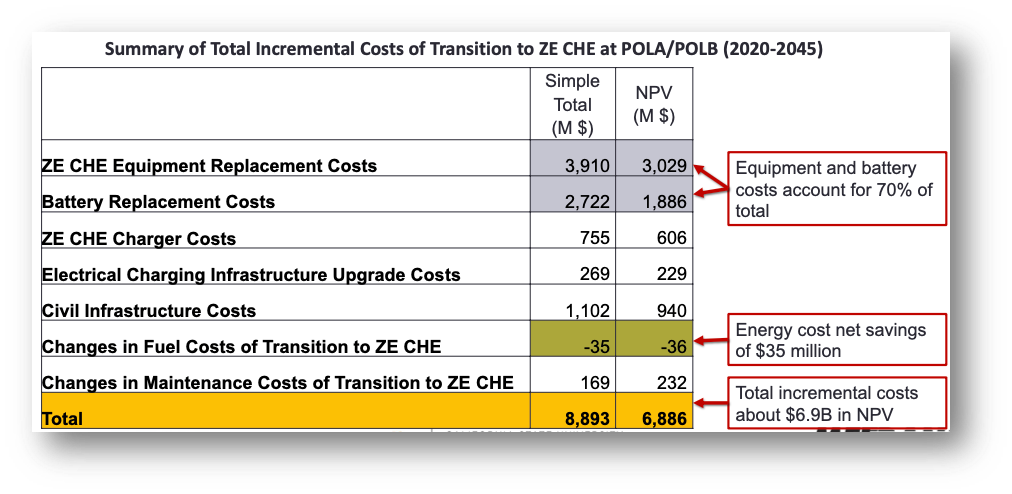
Direct costs/savings of transition to electric CHE
Looking at the macro-economic results, total employment, gross state product, state output, and personal income would all decrease as a result of electrifying cargo handling equipment. The impacts would vary over time, with the greatest losses in the earlier periods of the time span from 2020 to 2045. However, due to the size of California’s economy, the impacts are small in percentage terms. The top negatively impacted sectors include wholesale and retail trade, support activities for transportation and sightseeing transportation, and professional, scientific, and business services. The top positively impacted sectors would be general purpose machinery manufacturing, utilities, and electric equipment manufacturing.
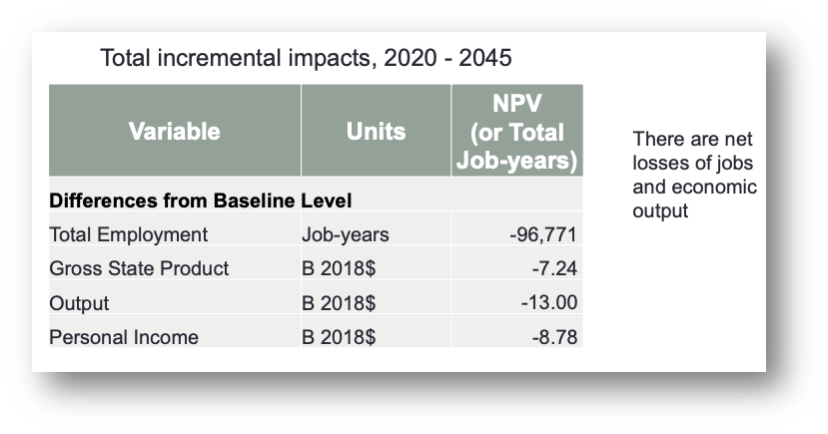
Macro-economic results
Wei continued on by analyzing the economic impacts depending on if any funding would be provided. Wei looked at 5 scenarios:
- Base Case: State incentive programs cover 10% of equipment and infrastructure costs; rest of costs borne by ports and passed onto downstream customers;
- Sensitivity Case 1: No state incentive funding 100% costs borne by ports;
- Sensitivity Case 2: The 10% government subsidy is offset by reductions in other government spending;
- Sensitivity Case 3: The 10% government subsidy is funded through an increase in gasoline tax; and,
- Sensitivity Case 4: Ports can only partially pass increased costs onto downstream customer.
With these different scenarios, the results yielded that various incentive programs can help improve economic performance. However, the improvements in economic performance will be reduced if the incentives provided have to be offset by reducing government spending or increasing the gasoline tax. If ports are able to pass partial costs onto downstream customers, macroeconomic impacts improve because of reduced negative supply-chain effects.
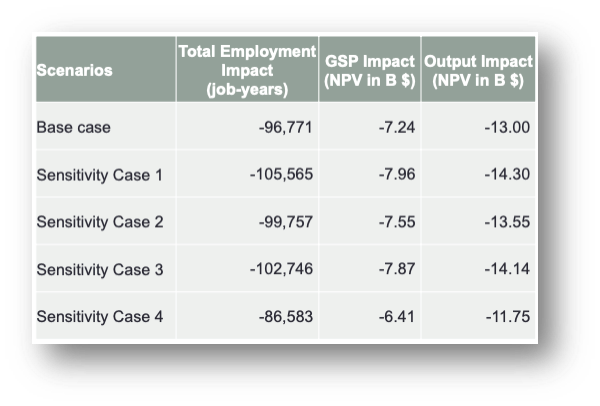
Sensitivity simulation results on funding sources
Wei wrapped up the presentation with a discussion of conclusions for the research. Wei estimated that incremental costs of electronification of cargo handling equipment at Port of Los Angeles/Port of Long Beach between 2020 and 2045 are estimated to be between $5 billion and $9.2 billion with equipment purchase and battery replacement costs accounting for more than 70% of the total incremental costs. Further, total employment impacts are estimated to be between 68 to 133 thousand job-years losses between 2020 and 2045. Lastly, Wei pointed that comprehensive impact evaluations should juxtapose economic impacts of the policy along with environmental and other co-benefits of the regulation.
About the Author:
Hayley Rundle is a second-year Master of Urban Planning student at the USC Price School of Public Policy, concentrating in Mobility and Transportation Planning. Hayley is interested in sustainable transportation planning to improve environmental quality, equity, and mobility for all. Hayley serves as the team leader for the METRANS Industry Engagement and contributes to the Student Research Team, summarizing cutting edge transportation research projects and findings for the METRANS Fast Facts for Students series.
News Archive
- December (1)
- November (6)
- October (4)
- September (2)
- August (3)
- July (4)
- June (3)
- May (7)
- April (8)
- March (11)
- February (8)
- January (7)
- December (7)
- November (8)
- October (11)
- September (11)
- August (4)
- July (10)
- June (9)
- May (2)
- April (12)
- March (8)
- February (7)
- January (11)
- December (11)
- November (5)
- October (16)
- September (7)
- August (5)
- July (13)
- June (5)
- May (5)
- April (7)
- March (5)
- February (3)
- January (4)
- December (4)
- November (5)
- October (5)
- September (4)
- August (4)
- July (6)
- June (8)
- May (4)
- April (6)
- March (6)
- February (7)
- January (7)
- December (8)
- November (8)
- October (8)
- September (15)
- August (5)
- July (6)
- June (7)
- May (5)
- April (8)
- March (7)
- February (10)
- January (12)















